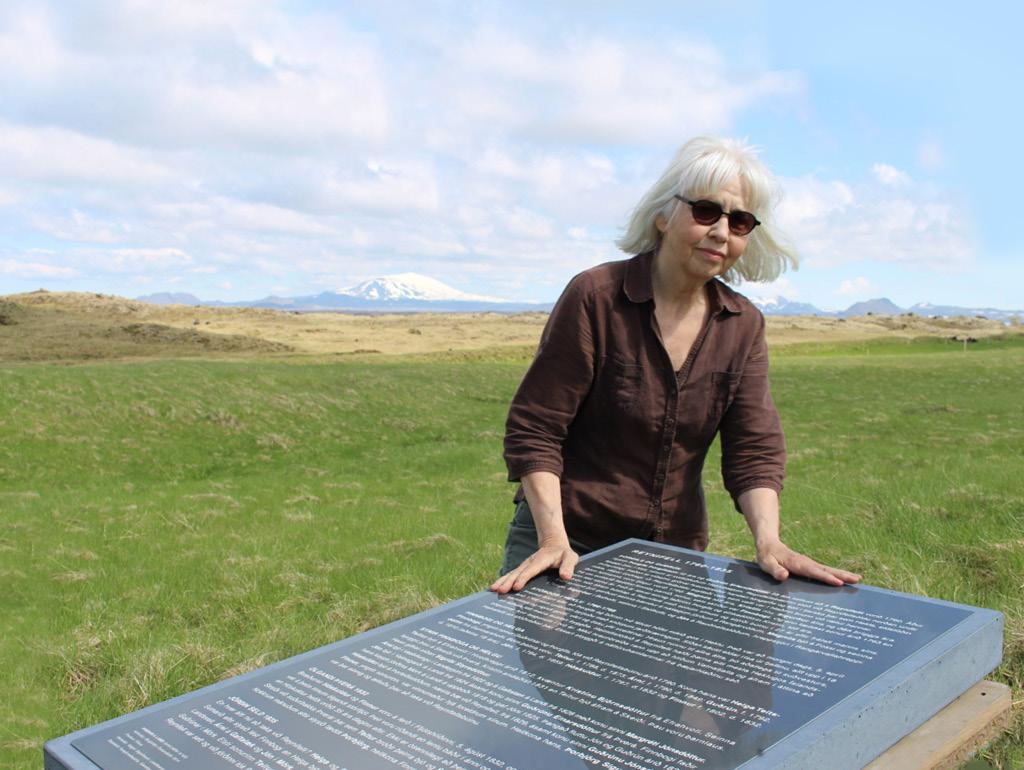
3 minute read
Field trip
Vettvangsferð í Stóra-Klofa
Farin var vettvangsferð í Stóra-Klofa, 13. maí. Margrét tók á móti okkur á hlaðinu við íbúðarhús sitt, en þar eru einnig hlaðnir veggir gömlu bæjarhúsanna. Margrét sagði hópnum söguna um flutning þess bæjar haustið 1879, þegar Höskuldur langafi minn og Arndís langamma hörfuðu undan sandstormi og landeyðingu og völdu þennan stað til að endurbyggja bæinn sinn Klofa. Í nýreista bænum fæddist síðan amma mín Ragnhildur, 20. janúar 1880.
Advertisement
Frá fjárhúsinu er um 5 mín. gangur í Skálann, stóran stálgrindarhjall, klæddan bárujárni og báruplasti. Gólfið er moldargólf blandað gráum vikri. Fremst er svæði sem Grétar hefur afmarkað sem smíðaverkstæði en það sem blasti við þar fyrir innan kom fólki á óvart. Opið rýmið var þétt raðað ólíkum hlutum, stórum og smáum, allt frá tauströngum, dýnum og húsgögnum yfir í hjólhýsi, báta og olíutanka. Á norðurgafli Skálans er stór vængjahurð, sem opnast mót víðáttu ósnertrar náttúru. Grétar upplýsti að margt af því sem þarna var eins og bátar og hjólhýsi, yrði fjarlægt fljótlega, það væri þarna til geymslu yfir veturinn. En þar fyrir utan voru staflar af öllu mögulegu og merkilegu, sem Grétar hefur á löngum starfstíma sem smiður bjargað frá því að lenda á ruslahaugum, eftir endurgerð húsakynna ýmissa fyrirtækja samkvæmt nýrri tísku. Hann bauð okkur að nýta allt þetta í verkin okkar eða á annan hátt á meðan sýningin stæði yfir.
Field trip
A field trip was made to Stóri-Klofi on 13 May 2020. Margrét welcomed us outside her home, where the stone walls of the old turf farmhouse remain standing. Margrét told us the story of how the farmstead was moved in the autumn of 1879, when my great-grandparents Höskuldur and Arndís fled sandstorms and desertification, choosing this site to rebuild their home, Klofi. My grandmother Ragnhildur was born in the newly-built farmhouse on 20 January 1880. Margrét invited us into her cosy living-room at Stóri-Klofi for coffee and the little pancakes called lummur. We all sat closely together, with no apparent fear of the coronavirus. Producing a carved wooden post, Margrét said that it was a connection between us – Margrét and me. She told me the story of a clairvoyant named Hafsteinn who visited Stóri-Klofi in the mid-20th century. He took the post, placed it against his forehead, and declared that it had been the right-hand post of the pulpit of Klofi Church.
After the coffee break we explored the exhibition area, which is to the north of the Land road. First we went to the old sheepshed, an evocative relic of past times, which would clearly be an attractive prospect for artists to interact with the rough-hewn natural building material and the proximity of the past. About five minutes’ walk from the sheepshed is the Shed, a large steel-framed structure, clad in corrugated iron and corrugated plastic. The earth floor is mixed with grey pumice. At the front is an area used by Grétar as a workshop, but what lay beyond took us by surprise. The big open space was crammed with the most diverse objects, large and small, from bolts of cloth, mattresses and furniture to caravans, boats and oil tanks. In the north wall of the Shed are large double doors, which open to face out into wide, untouched nature. Grétar told us that a lot of the stuff in the Shed would soon be removed, as it was stored there for the winter. But in addition to those things were stacks of all sorts of curiosities that Grétar has salvaged, during his long career as a builder, from being discarded onto scrapheaps, after the renovation of various business premises in keeping with the latest trends. He said we were welcome to use these materials in our works, or for other purposes, during the exhibition. The field trip gave rise to various ideas among the artists. They were now conscious that, in addition to beautiful nature and connections with livestock and olden times, the place also offered interesting allusions to the excesses of our own era.
Borghildur vinnur við verkið Þræðir á Landi 2014.


